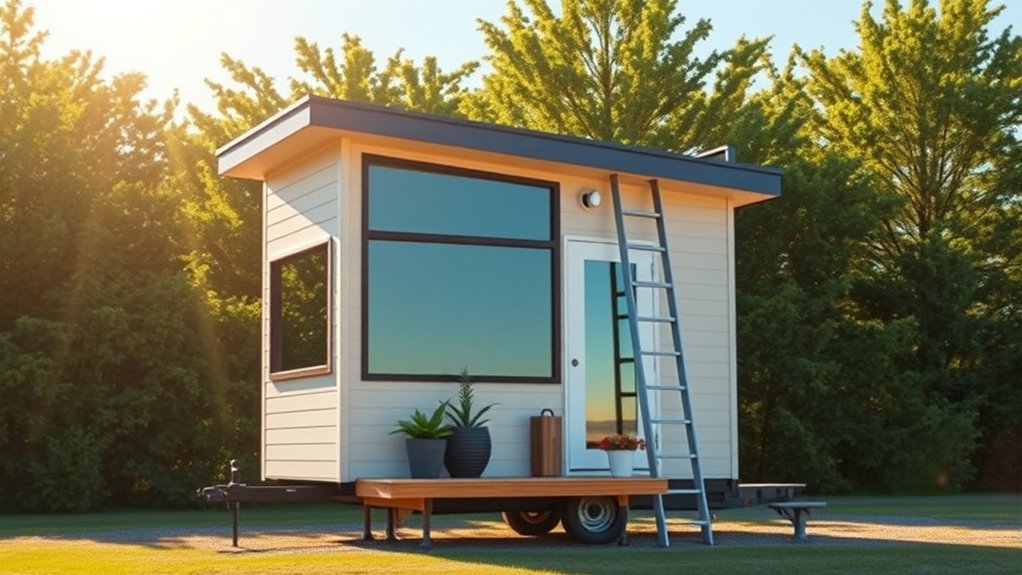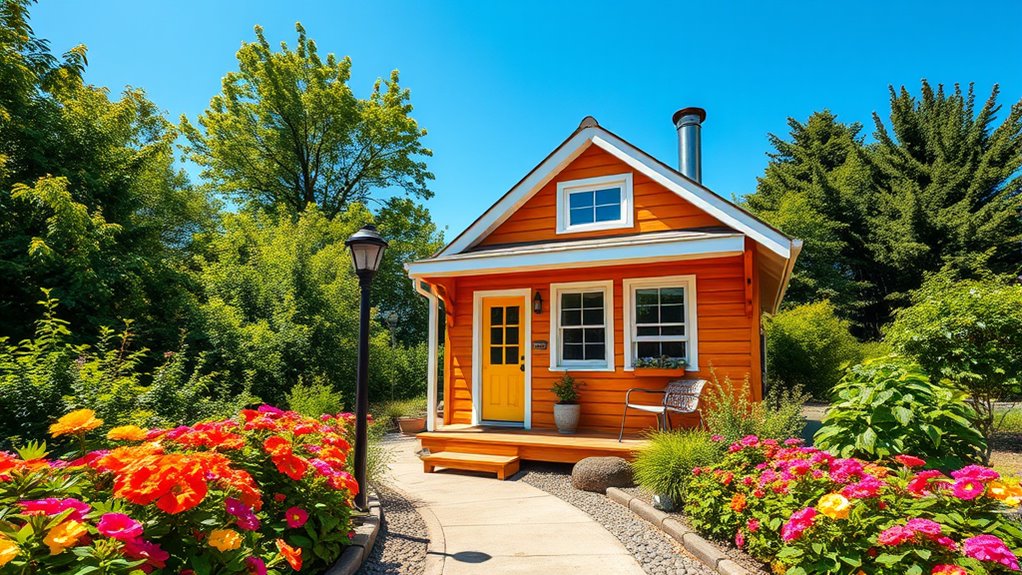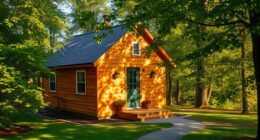If you’re exploring tiny houses, you’ll want to know about storage options, building regulations, and whether to build on a foundation or wheels. Smart solutions like multi-purpose furniture and ceiling shelves help maximize space. Local building codes and permits are vital to guarantee legality and safety, especially if building on a foundation. Tiny houses on wheels follow different rules, often classified as RVs. Keep these essentials in mind, and discover even more helpful tips ahead.
Key Takeaways
- Common questions cover building codes, foundation vs. wheel-based options, and legal requirements for tiny houses.
- Storage solutions focus on maximizing space through multi-functional furniture and smart organization.
- Building on foundations involves local zoning laws, while wheel homes may qualify as RVs with different regulations.
- Ensuring compliance with permits and safety standards prevents legal issues and promotes safe living.
- Proper planning and research help optimize space, meet legal requirements, and ensure a smooth tiny house experience.

Are you curious about tiny houses and whether they might be the right choice for you? One of the first things to consider is how you’ll manage storage within such a compact space. Tiny houses require creative storage solutions to maximize every inch. Think vertically—install shelves up to the ceiling, use multi-functional furniture like beds with drawers underneath, or incorporate fold-away tables and chairs. Every piece should serve more than one purpose, helping you keep your living area organized and clutter-free. Smart storage not only makes your tiny house more livable but also guarantees you can comfortably store all your essentials without feeling cramped.
Another important aspect to consider is building codes. You might wonder if your tiny house complies with local regulations. Building codes can vary widely depending on where you plan to build or park your tiny home. Some areas have specific requirements for minimum square footage, ceiling heights, or sanitation standards. Others might classify tiny houses as RVs, which have different rules altogether. Before starting construction or purchasing a tiny house, it’s essential to research your local building codes thoroughly. You may need permits or inspections to guarantee your tiny house is legally compliant. Ignoring these regulations can lead to fines, forced removal, or difficulties when trying to connect utilities like water and electricity.
When it comes to constructing your tiny house, understanding building codes helps you avoid surprises and guarantees your home is safe and legal. If you plan to build on a foundation, you’ll need to follow local zoning laws and building regulations just like any traditional home. On the other hand, if you’re considering a tiny house on wheels, you’ll need to check if it qualifies as an RV or trailer, which might exempt you from some building standards but introduces other rules, especially related to road safety and parking. Navigating these codes can seem overwhelming at first, but it’s worth the effort to guarantee your tiny house is compliant and protected.
Ultimately, planning for effective storage solutions and understanding building codes are essential steps in your tiny house journey. These considerations influence your design choices and legal standing, making your tiny house not only a smart lifestyle choice but also a safe and legal one. Taking the time to research your local rules**** and think creatively about storage will help you create a cozy, functional space that fits your needs and stands up to inspections, giving you peace of mind as you enjoy your tiny living experience.
Frequently Asked Questions
Can I Legally Park a Tiny House on Public Land?
You generally can’t legally park a tiny house on public land without checking local zoning restrictions and parking regulations. Many public areas prohibit permanent structures, and parking rules vary widely. Before attempting to park your tiny house, consult local authorities or land management agencies to guarantee you’re compliant. Ignoring these rules could lead to fines or having your tiny house removed, so always verify the legalities beforehand.
How Do I Ensure Proper Insulation in a Tiny House?
To guarantee proper insulation in your tiny house, start by selecting quality insulation materials like spray foam, rigid foam boards, or fiberglass batts. Install thermal barriers around walls, floors, and ceilings to prevent heat loss. Seal all gaps and cracks to improve energy efficiency. Proper installation and choosing the right insulation materials help maintain a comfortable temperature year-round, saving you energy and reducing costs.
What Are the Best Ways to Finance a Tiny House?
Think of financing your tiny house like planting a seed—you need the right method to grow it. You can explore personal loans, credit unions, or specialized lenders for tiny house design and portable tiny homes. Some folks even consider RV loans or crowdfunding. Research options thoroughly, compare interest rates, and choose what fits your budget best. With patience and planning, you’ll watch your tiny house dream flourish.
Are Tiny Houses Suitable for Harsh Winter Climates?
Yes, tiny houses can be suitable for harsh winter climates if you prioritize proper winter insulation and snow management. You should guarantee your tiny home is well-insulated to retain heat and prevent drafts. Additionally, plan for effective snow management around your property, like roof snow guards and clearing pathways regularly. With these precautions, you can stay warm and safe, enjoying your tiny house even in severe winter weather.
How Do I Find Tiny House Communities or Neighbors?
You can find tiny house communities or neighbors by exploring community networks online, like Facebook groups or specialized forums. Attend social events and tiny house festivals to meet like-minded individuals and get firsthand info. Visiting existing communities or staying in tiny house parks can also help you connect. Engaging actively in these networks and events makes it easier to find friendly neighbors and discover communities that match your lifestyle preferences.
Conclusion
So, now you’re practically a tiny house expert—ready to downsize your dreams and maybe even your belongings. Remember, living tiny means big adventures (and tiny bills). Just don’t forget, the only thing smaller than your house might be your patience for those “cozy” moments. But hey, at least you’ll always have room for one more pizza box. Happy tiny living—where the only thing bigger than your questions is your newfound freedom!









